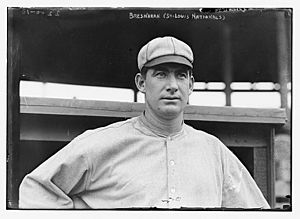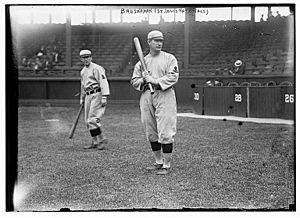Roger Bresnahan facts for kids
Quick facts for kids Roger Bresnahan |
|||
|---|---|---|---|
 |
|||
| Catcher / Outfielder / Manager | |||
| Born: June 11, 1879 Toledo, Ohio, U.S. |
|||
| Died: December 4, 1944 (aged 65) Toledo, Ohio, U.S. |
|||
|
|||
| debut | |||
| August 27, 1897, for the Washington Senators | |||
| Last appearance | |||
| October 3, 1915, for the Chicago Cubs | |||
| MLB statistics | |||
| Batting average | .279 | ||
| Home runs | 26 | ||
| Runs batted in | 530 | ||
| Managerial record | 328–432 | ||
| Winning % | .432 | ||
| Teams | |||
As player
As manager
|
|||
| Career highlights and awards | |||
|
|||
| Induction | 1945 | ||
| Election Method | Veterans Committee | ||
Roger Philip Bresnahan (June 11, 1879 – December 4, 1944) was a famous American baseball player and manager. He was known by the nickname "The Duke of Tralee". Roger played for several teams in Major League Baseball (MLB), including the New York Giants and St. Louis Cardinals.
Bresnahan started his career as a pitcher and also played as an outfielder. He later became a regular catcher. He was part of the 1905 World Series champion team. Roger Bresnahan is also famous for making baseball safer. He was the first to introduce shin guards for catchers in 1907 and even helped develop the first batting helmet. After his playing days, he stayed involved in baseball as a coach and team owner. He was elected to the National Baseball Hall of Fame in 1945.
Contents
Roger Bresnahan's Early Life
Roger Bresnahan was born in Toledo, Ohio, on June 11, 1879. His parents, Michael and Mary Bresnahan, came from Tralee, Ireland. Roger often joked that he was also from Tralee, which earned him his famous nickname, "The Duke of Tralee."
He started playing baseball in elementary school. Roger became well-known as a great player on local "sandlot" teams. He continued to play baseball when he attended Toledo's Central High School.
Roger's Baseball Career
Starting in Baseball (1895–1902)
At just 16 years old, Roger Bresnahan signed with a semi-professional team. After high school, he joined the Lima team in the Ohio State League. There, he mostly played as a pitcher, but also as a catcher in 1895 and 1896.
In 1897, the Washington Senators of the National League (NL) bought Roger's contract. He made his MLB debut as a pitcher on August 27, 1897. He pitched a great game, allowing no runs and only six hits. For the 1897 season, he had a strong 4–0 record. However, the Senators released him after a disagreement about his salary.
Roger then played for minor league teams like the Toledo Mud Hens and the Minneapolis Millers. In 1900, he played two games as a catcher for the Chicago Orphans in the NL. When the American League (AL) started, Roger joined the Baltimore Orioles. The Orioles' manager, John McGraw, signed him. Roger played as a catcher and an outfielder for the Orioles.
Becoming a New York Giant (1902–1908)
In 1902, Roger Bresnahan joined the New York Giants in the NL. This happened after some changes with his previous team, the Baltimore Orioles. John McGraw, who had been Roger's manager in Baltimore, also moved to the Giants.
At first, the Giants had other catchers, so McGraw played Roger in center field. In 1903, Roger had a fantastic season, batting .350, which was almost the best in the NL. In 1904, he played many different positions as the Giants won the NL championship.
In 1905, Roger became the Giants' main catcher. The famous pitcher Christy Mathewson especially liked pitching to him. Roger caught all five games of the 1905 World Series. The Giants won the World Series, and Roger led his team with a .313 batting average in the series.
Making Baseball Safer
Roger Bresnahan was a pioneer in making baseball safer. On Opening Day in 1907, he started using shin guards. While some other players had tried protective gear, Roger made them popular. Fans were surprised to see him wear them, and some even threw snowballs! But soon, other catchers started using shin guards too.
Roger also designed the first batting helmet. In 1907, he was hit in the head by a pitch and was badly hurt. While recovering, he drew plans for a plastic helmet. Even though batting helmets didn't become common until the 1940s, Roger's idea was way ahead of its time. He was also the first catcher to wear a padded facemask.
In 1908, Roger played a career-high 138 games as catcher. He batted .283 and led the NL in walks.
Leading the St. Louis Cardinals (1909–1912)
After the 1908 season, the Giants traded Roger to the St. Louis Cardinals. He became the team's player-manager, meaning he played and managed the team at the same time. The Cardinals had not been winning many games, but Roger helped them improve. Under his leadership, the team started winning more games, and more fans came to watch.
The team's owner was happy and gave Roger a five-year contract. However, the owner passed away in 1911, and his niece, Helene Hathaway Britton, took over the team.
In July 1911, the Cardinals were involved in a serious train accident. Their train derailed, and many people were hurt or killed. Luckily, none of the Cardinals players were seriously injured. This was because Roger had asked for their train car to be moved to a different spot before the trip. The team even helped rescue injured people.
Roger and the new owner, Helene Britton, had disagreements in 1912. The team's performance also dropped. Because of these issues, the Cardinals fired Roger after the 1912 season.
Final Years in Baseball (1913–1931)
After leaving the Cardinals, Roger signed a contract with the Chicago Cubs. He played for them and also served as their player-manager in 1915. However, his batting average dropped, and the Cubs decided to replace him.
The Cubs helped Roger buy the Toledo Mud Hens, a minor league team, in 1916. Roger played for the Mud Hens until 1918, when he announced his retirement. He later coached for the New York Giants from 1925 to 1928 and for the Detroit Tigers in 1930 and 1931.
Roger Bresnahan's Legacy

Roger Bresnahan played 1,446 games in his career. He had a batting average of .279, with 26 home runs and 530 runs batted in. As a manager, his record was 328 wins and 432 losses.
Roger was known for being a very emotional and intense player. He often argued with umpires and was sometimes ejected from games. Despite his fiery personality, he was a respected player.
Roger Bresnahan passed away on December 4, 1944, at age 65. He was elected to the National Baseball Hall of Fame in 1945, the year after he died. His important contributions to baseball, especially his efforts to make the game safer with shin guards and batting helmets, are a big part of his legacy.
See also
- List of Major League Baseball player-managers




